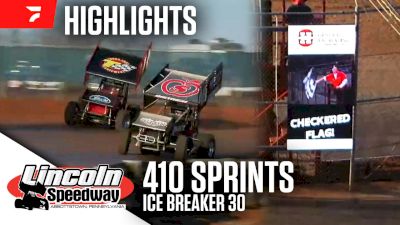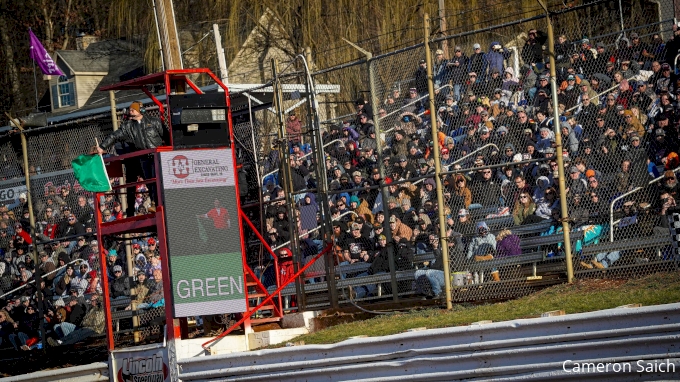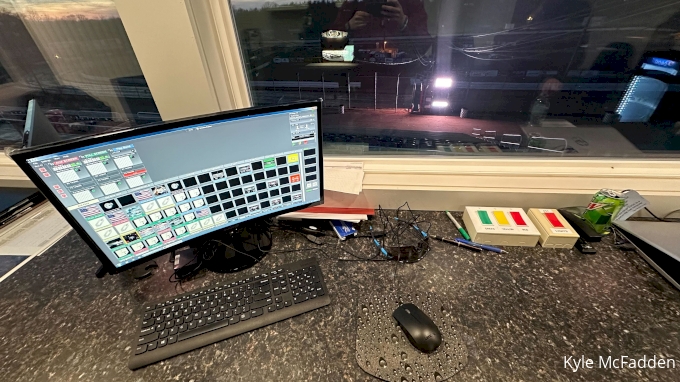An Inside Look At Lincoln Speedway's Virtual Flagging System
An Inside Look At Lincoln Speedway's Virtual Flagging System
Lincoln Speedway in Abbottstown, Pa., is the first dirt-track in the country to use a virtual flagging system. Here's an inside look at how it works.

Lincoln Speedway, the 3/8-mile clay oval in Abbottstown, Pa., that’s been operating since 1953, is doing something this year that no dirt-track in the United States has done before.
That, specifically, is a virtual flagging system, which debuted during Sunday’s Ice Breaker, the season opener that ushered in another busy year of Sprint Car racing across Central Pennsylvania. What’s that entail exactly?
It means the traditional flagman is being phased out at the famed oval as LED message boards at the start-finish line and lighting systems (which already exist around the speedway) now alert drivers and spectators of important on-track happenings, like green, yellow and red flags. Race director T.J. Leiby assumes control of the flagging system from the scoring tower.
Lincoln officials are employing an actual flagman for at least the first two weeks of its season to ensure a smooth transition from the old modus operandi to the new and innovative. Then, as soon as March 9, a new era officially begins when the flag stand is unoccupied.
“I think the virtual flagman will be the thing to come for a lot of different tracks for a lot of different reasons,” Lincoln Speedway co-owner Jerry Parrish told FloRacing on Sunday. “It’s a safety thing to begin with. You get two people out of harm’s way. If the (LED message) board has enough size to it, you can display a lot of things at one time to the drivers. I didn’t hear any complaints from the drivers.”
‘It’s Innovative:’ Virtual Flagging System Earns Dietrich’s Support

Terry Leiby serves as the traditional flagman for at least through Lincoln Speedway's March 2 program to ensure a smooth transition for the virtual flagging system. (Cameron Saich)
Innovative is, of course, an appropriate adjective to use here. Safer fits, too, as the virtual flagging system supplants the traditional, human flagman that’s put in harm’s way whenever high-powered race machines are pushing the limits just mere feet below the flag stand.
Parrish and the management at Lincoln are aware of backlash and pushback from race fans around Central PA and afar regarding the virtual flagging system. It goes against tradition, something dirt-track racing supporters tend to fiercely hold onto and safeguard.
But in this case, Danny Dietrich, who’s never slow to share his opinion, implies that innovation trumps tradition.
“I really don’t have much of an opinion other than it’s innovative,” Dietrich said. "When you’re racing at nighttime, you’re going to see it more so than during the daytime. With the sun shining, it’s hard to see it. But it’s that way for everything. I couldn’t see into turn three with 10 to go.
“At nighttime, it’s going to be hard to miss it. I’m not one to really look at the flagman unless it’s two to go or one to go, or the checkered. We have lights all the way around the track for yellows and reds, and you have someone on the radio. To me, as a driver, it’s not that big of a deal. There’s been a lot of close calls with some flagmen whether it’d be at Bridgeport (Motorsports Park in New Jersey) or here.
“I mean, the year before last, I landed up in the grass (in turn four). Chase (Dietz), too. There’s been a lot of close calls for flagmen. We don’t need to have that. Typically cars don’t (wreck) to the infield. So the corner (flagmen), that’s not a big deal. But the flagmen sitting up there where people and debris go by all the time, (the virtual flagging system is) good.”
Dietrich added that displaying lineups on the LED message boards “would make life a lot easier” so the timing and scoring “doesn’t yell at us on the radio.”
“I feel like you can put the lineups on the board and do four rows at a time, and have that flipping pretty quick,” Dietrich said. “You can probably see that pretty easy.”
Parrish, Leiby and the Lincoln staff are a step ahead of Dietrich, already brainstorming what additional animations they can display on the message boards once they get the basics squared away.
“Of course, this is our first time using it,” Parrish said. “We’re going to learn and improve on it every week. We’ll be more comfortable with it. … We’re in the entertainment business whether we like it or not. Yes, we’re racers, but we’re in the entertainment business. We need to make it interactive for the fans. Hence, the second board (facing the grandstands). It brings it to another level.”
Besides, cutting-edge improvements and scrutiny from that is not something new to Lincoln’s management group of Parrish, Alan Kreitzer, Mike Heffner, and Scott Gobrecht. In 2019, the track became the first in Central PA to install a Jumbotron in the infield, something “a lot of fans complained about,” Parrish added.
“Now, people enjoy it,” Parrish said.
‘Why Don’t We Try To Set A Precedent?’

T.J. Leiby inside Lincoln Speedway's scoring tower where he commands the virtual flagging system. (Kyle McFadden)
Leiby takes the responsibility of manning the virtual flagging system to heart. Not because he’s trying to be pretentious or challenge the status quo out of selfish ambition, but he wants to see the sport in its healthiest state.
“It’s definitely a big role,” Leiby said. "I want to have a united front with all of our officials. Like, yes, I will have say over them, but I want to work as one unit and have everybody who’s working here wanting to work here. We’re not here for the money. We’re here because we love the sport. That’s my main goal.”
Leiby, whose grandfather Don owned Lincoln for 26 years before the current management group took over in 2019, is in his 20th year working at the Abbottstown, Pa., oval. He started as a 13-year-old in 2004 manually operating the track’s turns three and four scoreboard.
He’s the third-longest active staffer at Lincoln behind announcer Wayne Harper and Tina Shaffer, who oversees timing and scoring. Both have been at Lincoln since 1993.
Leiby took over race directing duties at the speedway last May and has spearheaded the virtual flagging system along with William Gigeous, the son of longtime videographer Steve Gigeous, since the idea took form last fall when Lincoln’s longtime flagman Glenn Wanbaugh resigned from the position.
“We shot around the idea, if our flagman retires, what do we do if we can’t find somebody?” Leiby said. “This idea has been on the back burner. … Then we thought, why don’t we try it? Why don’t we try to set a precedent here? Let’s be the first, in the U.S. that I know of, to do this.”
Australia’s Perth Motorplex uses a virtual flagging system, but it’s not as advanced as what Lincoln is attempting to accomplish. The assembly of the LED message boards and system altogether from Impact Signs of Sedalia, Mo., costs approximately $50,000, according to Parrish.
“You may never recoup that money, but you have to remember, you’re adding something to your show,” Parrish said. “It’s also a good spot to put an advertiser there (H&H General Excavating of Spring Grove, Pa., is the official sponsor of the LED message boards). You can’t not look at the board, whether it’s the driver or the fans.”
To that point, Dietrich, as he mentioned, doesn’t really look at the flagman during a race unless there’s less than two laps to go. Nowadays virtually every dirt race across America is controlled by the race director who typically carries out those duties from the scoring tower.
“I’m on the radio calling the yellows to the officials because they have to wait until we call it up here so we are in sync,” Leiby said. “That’s the timing and stuff we have to get down.”
Are Virtual Flagging Systems A Look Into The Future?

Lincoln Speedway virtual flagging system: The computer that manages the message board's animations and the lights that trigger the the lighting systems. (Kyle McFadden)
Realistically, the traditional flagman likely won’t ever be superseded at majority of dirt tracks across the nation. But Leiby hopes he and Lincoln can show dirt tracks another way — perhaps, the modern and safer way — of officiating.
“I love it. At least for me, it’s intriguing; to be the first in the states (to have a virtual flagman),” Leiby said. “We’re going to do this correctly. We can set a precedence for tracks around the country or even around the world. It’s literally the start of something, as they call it nowadays, viral.”
Dietrich thinks “other tracks in the area will probably start doing it, (the virtual flagging system,” adding that “insurance has to like it” but more so because “it’s cool for the fans.”
He also doesn’t buy into the notion that the virtual flagging system is detrimental to the younger demographic, to the children that bring toy flags to the races and wave them as they look on from the stands.
“You have to be positive about it,” Dietrich said. “If it’s negative we’ll make sure it’s known. But until something bad happens, there’s no reason to bash it. It’s not replacing somebody’s job. … Sure, the kids like the flag. But there’s plenty of things out there (for the kids to like).”
It’s not like the message boards are merely another lighting system, if a race is green, yellow, red, checkered, or whatever else. The speedway has animations of Leiby’s father, Terry, waving the appropriate flag on the message boards to honor the tradition of the flagman.
Leiby and company would also like to add lap counts, qualifying rundowns, lineups and more animations to the messages boards, too.
“We need to master this before we move onto the next thing,” Leiby said. “There’s so many things we can do this that we haven’t done. … We’re really looking to take this thing to another level.”
As far as the move over flag goes, the speedway’s tentative plan is to show “LEADERS APPROACHING, HOLD YOUR LINE” in bold lettering across the message boards for when the leader gets to slower traffic.
“But we’re not even sure if we’re going to display that because the (World of) Outlaws don’t display it,” Leiby said.
When the system reaches its potential, would Leiby be open to helping other racetracks interested in adopting the virtual flagging system?
“I’d definitely be. I am for the sport,” Leiby said. “Yes, I’ve been at Lincoln for 20 years. But my allegiance is to the sport of racing. Some people are like, ‘Oh, I won’t go to this track or that.’ I’m like, let’s support them all. If they all go away, what do you have left?”
If there’s anything to not gloss over through Lincoln’s transition from the old into what appears as the modern way of officiating, consider Dietrich’s following statement.
“You have to learn and adjust to it,” Dietrich said. “Hopefully it turns out to be a good thing. I think it will be. Fans have to be open-minded. At least they can see when the cautions come out and stuff. It’s going to take some time. But I think it’s going to be good.”